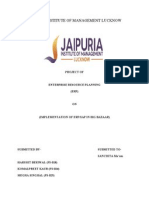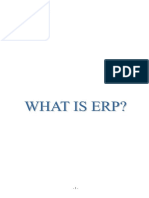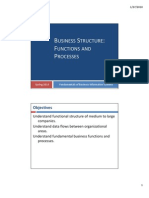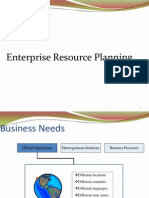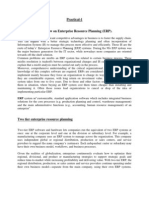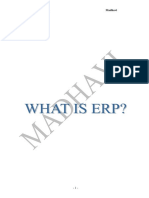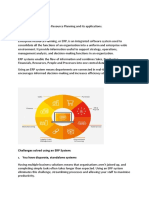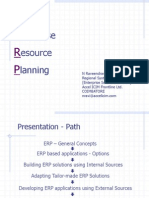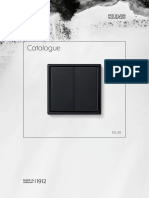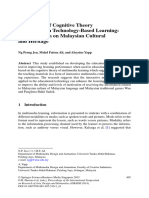ERP Basics: Report Usage
ERP Basics: Report Usage
Uploaded by
arslsaadCopyright:
Available Formats
ERP Basics: Report Usage
ERP Basics: Report Usage
Uploaded by
arslsaadOriginal Title
Copyright
Available Formats
Share this document
Did you find this document useful?
Is this content inappropriate?
Copyright:
Available Formats
ERP Basics: Report Usage
ERP Basics: Report Usage
Uploaded by
arslsaadCopyright:
Available Formats
UBIS Roadmap 1 Confidential All Rights Reserved Ernst & Young 2009
ERP Basics
Report usage
The information in this document and any oral presentations made by Ernst & Young contains trade secrets and confidential and proprietary information of Ernst &
Young, the disclosure of which would provide substantial benefit to competitors. As a result, this document should not be disclosed, used or duplicated in whole or
in part for any purpose other than your company using the deliverable for the purpose agreed between Ernst & Young and Sudapet. Any such sharing of information
in this document in full or part there of should be discussed and mutually agreed with Ernst & Young.
UBIS Roadmap 2 Confidential All Rights Reserved Ernst & Young 2009
E
Organisation wide
Across all geographic
& functional divisions
R P
All Resources
Man
Money
Material
Machines
Planning
Means looking at the
long term view rather
than just current
Enterprise Resource Planning (ERP)
UBIS Roadmap 3 Confidential All Rights Reserved Ernst & Young 2009
Introduction to ERP
An ERP is a packaged business software system that allows
organization to
Automate and integrate the business processes
Share common data and practices across the enterprise
Produce and access information in a real time mode
Lays the foundation for intelligence, integration, extended
enterprise
Forms the basis for business growth and expansion
Enterprise Resource Planning
Most of the products are internet enabled
ERP systems typically feature workflow management, intelligence
and controls
Componentized architecture
Industry specific products are the reality
Fast becoming extended enterprise applications
E-business has made procurement and CRM as competitive edges
The present picture
ERP packages have evolved over decades and are currently classified through international research
Tier 1: Large enterprise, large user base, multi site, multi national implementation, group companies, complex business architecture, more inclusive products (SAP,
Oracle (+JD Edwards) , BaaN, Microsoft dynamics AX is in transition)
Tier 2: Limited sites and companies, less user base, module and industry focused products in mid-tier, limited geographical reach (QAD, Orion, Microsoft NAV,
Epicor Vantage, Marshall, IFS, Mfgpro)
Tier 3 & 4: Single site, accounting packages, start ups (Microsoft GP, Accpac, Peach tree)
Tier classification
UBIS Roadmap 4 Confidential All Rights Reserved Ernst & Young 2009
An ERP system is a packaged business software system that allows an organization to:
What is ERP?
Automate and integrate the majority of its business processes
Share common data and practices across the entire enterprise
Produce and access information in a real-time environment
UBIS Roadmap 5 Confidential All Rights Reserved Ernst & Young 2009
ERP is a combination of business management practice and technology, where Information technology integrates with organization's core business processes to
enable the achievement of specific business objectives. It is used to manage and coordinate the resources, information, and functions of a business from integrated
business application.
All the departments are being served by the same integrated application through one point of entry. Information need only be entered or updated once, reducing errors,
time and labor for reports, analysis, and planning and program management. Ultimately, time and resources are shifted to innovation, problem solving and enhances
service to customers rather than inputting, processing, organizing and verifying, leading to greater efficiency and saving potential.
Complete Suite of integrated application
Financial & Accounting
Materials Management
Production Planning
Order Entry
Purchasing
Financial Control
Distribution/Logistics
Asset Management
Quality Management
Human Resource Management
R&D Management
Single Database
Same Master data objects
Data integrity
Data sharing
Modular Structure
Similar Interfaces
Cross functional Reports
Cross functional Tracking
Cross functional workflows
Finance
HR
Purchase
Inventory Sales
Architecture
Legacy Applications Enterprise Resource Planning
Function specific Application
Different Technology
No integration
Redundant Data Entry
Function Specific Modules
Modules are fully integrated
Same technology platform
All modules use same master data
Data Sharing
What is ERP?
UBIS Roadmap 6 Confidential All Rights Reserved Ernst & Young 2009
Key dimensions of ERP
Reference data
One time entry
Non-transactional in nature
Key to the operation of business
Example: Item, Employees, Suppliers
Masters
Day to day entries
Refers master data
Example: Purchase Order, Goods
receipt note, Delivery Note
Transactions
Quick Search
Key (Input Parameter) Driven
Examples : Item Status Query,
Purchase Order Status
Query
Routine set of procedures to convert one
form to another,
Example : Month end Processing, Goods
Receipt Note Processing, Loan
Processing
Processing
The purpose is to inform
Example : Slow moving item report,
Monthly Receipts
Report
M
P
T
R
Q
The purpose provide hard copy to
acknowledge.
Example : Goods receipt note,
Payment voucher
Document Print
D
UBIS Roadmap 7 Confidential All Rights Reserved Ernst & Young 2009
Sample (Procurement) flow in ERP
Comparison Report
Material Requisition Purchase Requisition Enquiry to Supplier
Quotation from Supplier
Purchase Order Goods Receipt Note
Inspection
Purchase Order
Document Print
GRN Document Print
Payment Voucher
(Accounts Payables)
Excess/Shortage/Quality
Report
Payment Voucher
Approval
Approval
Approval Approval
Approval
Processing
Item
Master
Vendor
Master
Item Status
Create/
Refer
Create/
Refer
Query
GL
(Inventory goes up)
Liability for supplier is created
Approval
Liability is paid
Approval
M
Q M
T
T
T
T
T T
D
D R
T
R D
T
P
Transactional Flow
UBIS Roadmap 8 Confidential All Rights Reserved Ernst & Young 2009
Key benefits
Standardization of master data
Reduced redundant entries
Data sharing between modules
Increased access to available data for
decision making
Information
Cross functional MIS reporting
Cross functional performance
measurement
Better reporting, e.g. purchase
forecasting
Reports
Provides greater and effective control.
Approval and authorizations
Greater accuracy of information.
Controls
Timely information
Searching is faster
Faster response and follow up
Alerts, e.g. stock below lead time
quantity
Time
Improved vendor performance
Reduced response time
Improved efficiency
Increased flexibility
Improved over all accuracy
Intangible
Streamlined processes and workflows
Reduced direct cost
Reduced quality cost
Improved productivity levels
Improved resource utility
More
UBIS Roadmap 9 Confidential All Rights Reserved Ernst & Young 2009
Establish steering committee
Allocate resource
Share, communicate and market the
initiative within the company
Initiate & Plan
Collect data on current processes and
systems (ASIS preparation)
Changes to business process
Data Coding and Classification
Highlight objectives and issues
Document/reports gathering, submit
correction
Product & Process
Mapping
Support the implementing partner during
configuration process
Prepare participants for training
Prepare business test cases .
Configuration
Data Cleansing
Perform readiness check
Cut over preparation
Formulate go-live strategy
Go Live
Conduct user acceptance testing
IT team to perform network testing
Testing
Champions and support team of
functional and IT
Ensure availability of the participants
Training
ERP Implantation & Expectations
Expectations from participating teams & users
UBIS Roadmap 10 Confidential All Rights Reserved Ernst & Young 2009
Challenges
Inability to foresee all project related
risks.
Installing appropriate review
mechanism.
Risk
Unrealistic project plan
Initiate & Plan
Challenges
Communicating key expectations
Addressing business requirements with
least application customization
Managing change management
Risk
Poor scoping and documentation
Lack of assessment of process controls
Product & Process
Mapping
Challenges*
Risk*
Configuration
Challenges
Timely quality data migration
Installing back-up, contingency and
recovery plans
Risk
Datacenter availability
Completion of sub projects on time.
Go Live
Challenges
Testing all the business scenarios
Following testing plan
Risk
Missing long cycle cases like year ending
Testing
Challenges
Ensuring participants availability
Making users ready for the transformation
Risk
Inadequate training to key users
Improper support from implementer
Training
Key Implementation : Risk and Challenges
*Implementation partner activity
UBIS Roadmap 11 Confidential All Rights Reserved Ernst & Young 2009
Success factors
Establish Effective and Efficient Business Processes
Balance application functionality and process improvements with appropriate level of internal control
Provide effective application and infrastructure security to enhance business processes while protecting corporate information systems assets
Establish Data Integrity
Provide reliable data for accurate and complete financial reporting
Provide reliable data for sound business decision making
Provide reliable data to ensure the timely and efficient processing of transactions
Establish Financial Controls and Monitoring Procedures
Establish key project objectives
Define KPIs and metrics with clear targets
Quantify expected benefit from implementing an ERP system
Align processes with KPIs to achieve strategic benefits
Maintain costs
UBIS Roadmap 12 Confidential All Rights Reserved Ernst & Young 2009
Frequently asked questions
How to prepare an organization for ERP implementation?
What is an ERP project team?
Who are the project champions?
What is the role of implementation partner?
What is the role of process-modeling tools ERP implementation?
What are drawbacks of over customization?
Changing business practice to suit the ERP software rather than customizing the software?
How is "data migration" managed for ERP implementation?
What does "going live" mean?
You might also like
- Enterprise Resource PlanningDocument4 pagesEnterprise Resource PlanningNithin CoolNo ratings yet
- Jaipuria Institute of Management LucknowDocument9 pagesJaipuria Institute of Management Lucknowalseran4ttyNo ratings yet
- 4.finance MaterialDocument467 pages4.finance Materialujjawal soniNo ratings yet
- Project ReportDocument27 pagesProject ReportBharti RaiNo ratings yet
- ERP2Document4 pagesERP2aadithNo ratings yet
- CH 1 Introduction To Enterprise Resource Planning SystemsDocument20 pagesCH 1 Introduction To Enterprise Resource Planning SystemsPurdianta YoNo ratings yet
- Enterprise Resource Planning (Document19 pagesEnterprise Resource Planning (Ninad KhuleyNo ratings yet
- Need For Enterprise Resource Planning: Business Integration and Improved Data AccuracyDocument3 pagesNeed For Enterprise Resource Planning: Business Integration and Improved Data AccuracyNahidh GhafoorNo ratings yet
- INF Chapter 7 SummaryDocument7 pagesINF Chapter 7 Summaryiamthelazyassassin20No ratings yet
- FI Material 2 PDFDocument568 pagesFI Material 2 PDFVishal YadavNo ratings yet
- 03 Business Structure Student VersionDocument11 pages03 Business Structure Student VersionjunkyardNo ratings yet
- EprDocument7 pagesEprSaleh AlgdaryNo ratings yet
- An Overview On ERP - Chapter 1Document26 pagesAn Overview On ERP - Chapter 1Puneet BansalNo ratings yet
- ERPDocument60 pagesERPSamNo ratings yet
- LectraDocument38 pagesLectraNiharika SinhaNo ratings yet
- SAP Is The World Leader in Enterprise Applications in Terms of Software and SoftwareDocument4 pagesSAP Is The World Leader in Enterprise Applications in Terms of Software and SoftwaresuneducationnedumangadNo ratings yet
- Enterprise Resource PlanningDocument44 pagesEnterprise Resource PlanningDeepika PatelNo ratings yet
- ERP Implementation4Document43 pagesERP Implementation4Senthil KumarNo ratings yet
- 1.-Sap ErpDocument14 pages1.-Sap ErpEdgardo Ascanio RegueiraNo ratings yet
- ERP - Enterprise Resource Planning (2023!07!18 17-22-53 UTC)Document69 pagesERP - Enterprise Resource Planning (2023!07!18 17-22-53 UTC)promie6969No ratings yet
- Literature Review On Enterprise Resource Planning (ERP)Document6 pagesLiterature Review On Enterprise Resource Planning (ERP)Sheel ShahNo ratings yet
- Information System Unit 4 NotesDocument33 pagesInformation System Unit 4 NotesNithya KarthikNo ratings yet
- Enterprise Resource Planning (ERP)Document15 pagesEnterprise Resource Planning (ERP)Ankita BoradeNo ratings yet
- Erp Complete FileDocument179 pagesErp Complete FileShanthiNo ratings yet
- What Is Erp?Document7 pagesWhat Is Erp?shahriar62No ratings yet
- ERPDocument28 pagesERPMehfuz PatelNo ratings yet
- Assignment 2 ErpDocument10 pagesAssignment 2 ErpAreeb Shahid100% (1)
- Subros (A4)Document2 pagesSubros (A4)mizbuzieyNo ratings yet
- FI Material PDF PDFDocument503 pagesFI Material PDF PDFRAJLAXMI THENGDI100% (1)
- ERPDocument28 pagesERPSinchit RajputNo ratings yet
- Characteristics: Enterprise Resource Planning (ERP) Is A Business Management SoftwareDocument4 pagesCharacteristics: Enterprise Resource Planning (ERP) Is A Business Management SoftwaresatishgwNo ratings yet
- Benefits of ERPDocument3 pagesBenefits of ERPNihmathulla ShariffNo ratings yet
- Assignment:Mit: Implementation of Erp in Manufacturing SectorDocument8 pagesAssignment:Mit: Implementation of Erp in Manufacturing SectorVimalan MathaiyanNo ratings yet
- Unit 1 Part ADocument42 pagesUnit 1 Part AShanthiNo ratings yet
- What Are Intelligent SystemsDocument15 pagesWhat Are Intelligent SystemsLOOPY GAMINGNo ratings yet
- Key Considerations For A Successful Hyperion Planning ImplementationDocument45 pagesKey Considerations For A Successful Hyperion Planning Implementationayansane635No ratings yet
- A Term Paper: Software Project ManagementDocument24 pagesA Term Paper: Software Project ManagementdimpibNo ratings yet
- Experiment No. 7 Aim: Study of Enterprise Resource Planning and Its ApplicationsDocument4 pagesExperiment No. 7 Aim: Study of Enterprise Resource Planning and Its ApplicationsYogesh KandaNo ratings yet
- Enterprise Resource PlannningDocument153 pagesEnterprise Resource PlannningSuraj PrakashNo ratings yet
- Enterprise Resource PlanningDocument26 pagesEnterprise Resource PlanningHemal Patel SamNo ratings yet
- IIT 13 - Enterprise Apps - ERP (Session 4)Document30 pagesIIT 13 - Enterprise Apps - ERP (Session 4)Sahil WadhwaNo ratings yet
- Business Process and ERP NewDocument108 pagesBusiness Process and ERP NewPrashant HiremathNo ratings yet
- Enterprise Resource Planning (Erp)Document34 pagesEnterprise Resource Planning (Erp)Manish_Kaushal_6867No ratings yet
- Enterprise Resource PlanningDocument5 pagesEnterprise Resource PlanningkavithagowriNo ratings yet
- Enterprise Resource PlanningDocument2 pagesEnterprise Resource Planningtanjai_sureshNo ratings yet
- Extended Erp (Bi) - Final Project PresentationDocument32 pagesExtended Erp (Bi) - Final Project Presentationajjukuce1981No ratings yet
- Enterprise Resource Planning (ERP) Systems Integrate Internal and ExternalDocument14 pagesEnterprise Resource Planning (ERP) Systems Integrate Internal and ExternalYl WongNo ratings yet
- ErpDocument37 pagesErpanitikaNo ratings yet
- Gaya ErpDocument12 pagesGaya ErpGayathri VNo ratings yet
- Business Case - Item Master EnrichmentDocument12 pagesBusiness Case - Item Master EnrichmentMohamed Azarudeen100% (1)
- Class PresentationDocument142 pagesClass PresentationFaisal RashidNo ratings yet
- Erp RevDocument6 pagesErp RevJoms LucerioNo ratings yet
- Edited - Module 1 - ERPDocument29 pagesEdited - Module 1 - ERPHazel SerranoNo ratings yet
- Function Points?: David LongstreetDocument55 pagesFunction Points?: David LongstreetCibyBaby PunnamparambilNo ratings yet
- ERP AmritaDocument45 pagesERP AmritaUmair KhalidNo ratings yet
- Top 20 ErpDocument96 pagesTop 20 ErpAdnan AbuShahad100% (1)
- Prelipcean Razvan - Group 2 - Essay Enterprise Resource PlanningDocument7 pagesPrelipcean Razvan - Group 2 - Essay Enterprise Resource Planningfumata23415123451No ratings yet
- Low-Code Application Development with Appian: The practitioner's guide to high-speed business automation at enterprise scale using AppianFrom EverandLow-Code Application Development with Appian: The practitioner's guide to high-speed business automation at enterprise scale using AppianNo ratings yet
- BE 5 Sem RW2015Document1 pageBE 5 Sem RW2015Mohanish JaiswalNo ratings yet
- Fpgas: An Overview: Sanjiv MalikDocument24 pagesFpgas: An Overview: Sanjiv MalikSiva KrishnaNo ratings yet
- Java FSDDocument2 pagesJava FSDjicesag354No ratings yet
- Flash Memory Lifespan and Reliability White PaperDocument10 pagesFlash Memory Lifespan and Reliability White PaperpepeparraNo ratings yet
- JUNG Catalogue en 28Document744 pagesJUNG Catalogue en 28khaled shboulNo ratings yet
- A Simheuristic Approach Using The NSGA II To Solve A Bi Objective Stochastic Flexible Job Shop ProblemDocument26 pagesA Simheuristic Approach Using The NSGA II To Solve A Bi Objective Stochastic Flexible Job Shop ProblemCamilo RodriguezNo ratings yet
- Audio and Video Config PDFDocument12 pagesAudio and Video Config PDFDanna Valentina Holguin DíazNo ratings yet
- TEXI 1501 Manual ENDocument48 pagesTEXI 1501 Manual ENJosip LancicNo ratings yet
- Application of Cognitive Theory in Multimedia Technology-Based Learning: Concentration On Malaysian Cultural and HeritageDocument8 pagesApplication of Cognitive Theory in Multimedia Technology-Based Learning: Concentration On Malaysian Cultural and Heritagejf.leungyanNo ratings yet
- Fermator Operating PDFDocument16 pagesFermator Operating PDFEusebio Espinoza100% (2)
- Fortios v6.2.3 Release NotesDocument63 pagesFortios v6.2.3 Release NotesRafael UlmusNo ratings yet
- Comp 352 Study GuideDocument16 pagesComp 352 Study GuideAleksander GjokaNo ratings yet
- Online Election Management SystemDocument18 pagesOnline Election Management SystemsparshuuworkNo ratings yet
- Unit1 Kumod DeeplearningDocument160 pagesUnit1 Kumod DeeplearningRichaNo ratings yet
- Chapter 5 Transformations of The Euclidean PlaneDocument14 pagesChapter 5 Transformations of The Euclidean PlaneLitoy ArquizaNo ratings yet
- IP Lab (MRKIT)Document41 pagesIP Lab (MRKIT)Sathyamurthy DuraikkannuNo ratings yet
- 6 Figure OnlyFans - 2022Document20 pages6 Figure OnlyFans - 2022Pedro Guerra100% (5)
- 01-Electronic New Government Accounting SystemDocument61 pages01-Electronic New Government Accounting SystemRoshel DoriendesNo ratings yet
- BakerHughes BN ReciprocatingCompressorsMonitoring Brochure-Web-NA-1112...Document9 pagesBakerHughes BN ReciprocatingCompressorsMonitoring Brochure-Web-NA-1112...Abbas AlnajjarNo ratings yet
- Health Form For Civil Service ExamDocument1 pageHealth Form For Civil Service Examralph sabaNo ratings yet
- Electronically Stored InformationDocument53 pagesElectronically Stored Informationdurteslande9100% (6)
- 80+ ChatGPT Prompts for Project Managers - AI HabitDocument20 pages80+ ChatGPT Prompts for Project Managers - AI Habitanirban7172No ratings yet
- Intro To Shell ScriptsDocument19 pagesIntro To Shell Scriptskkrrcb.8745No ratings yet
- M&E CRM Logs Process Flow (Corrective Maintenance) : StartDocument1 pageM&E CRM Logs Process Flow (Corrective Maintenance) : StartFaratul NiaNo ratings yet
- Catalogo HAKKO 2014Document66 pagesCatalogo HAKKO 2014Diego Hermosilla MotaNo ratings yet
- Annamalai MBA Solved Assignment 2020Document33 pagesAnnamalai MBA Solved Assignment 2020AiDLo0% (1)
- UE Cabability Note 5Document30 pagesUE Cabability Note 5Khalid Waleed KhaleelNo ratings yet
- Gcs - Gecb: Service Tool ManualDocument29 pagesGcs - Gecb: Service Tool ManualAju S NairNo ratings yet
- A.2.3 Describe How A DBMS Can Be Used To Promote Data Security. Database SecurityDocument3 pagesA.2.3 Describe How A DBMS Can Be Used To Promote Data Security. Database SecurityPreeti SinghalNo ratings yet
- Proposal Final DraftDocument5 pagesProposal Final DraftsmileyfaceedwardsmileyfaceNo ratings yet

